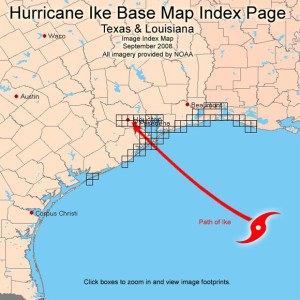

Sept.13 marks the fifth anniversary of the landfall of Hurricane Ike on the Texas coast. Despite its Category 2 ranking when it hit, Ike caused more than $30 billion in damage and the lessons learned from it could be crucial ones for future preparedness, says a Texas A&M storm expert.
John Nielsen-Gammon, a professor of atmosphere sciences who also serves as State Climatologist, says Ike was not your normal storm. It was far more powerful than many believed at the time.
Ike made landfall at 2:10 a.m. on Sept. 13 over Galveston. Winds were clocked at 110 miles per hour, putting it into the Category 2 ranking, one reason why many people did not heed warnings to leave.
“Ike was a big storm that almost filled the entire Gulf of Mexico,” Nielsen-Gammon explains.
 “But it was not especially an intense storm. What made Ike so dangerous was the huge storm surge it created. It was a Category 2 storm that produced Category 4 storm surge. The storm surge began earlier than forecasted, and it took a lot of people off guard.
“But it was not especially an intense storm. What made Ike so dangerous was the huge storm surge it created. It was a Category 2 storm that produced Category 4 storm surge. The storm surge began earlier than forecasted, and it took a lot of people off guard.
“That has to be one big lesson we learned from Ike: a moderate storm can still pack a very big punch.”
Storm surge reached a record 22 feet at Sabine Pass and was 15-20 feet at numerous other locations.
More than 100,000 homes and businesses were flooded, most of them in the Galveston area. The small towns of Crystal Beach and Gilchrist were virtually destroyed.
Despite repeated warnings from officials to leave, it is estimated that as many as 40 percent of residents in the mandatory evacuation zone – most of them in Galveston – decided not to evacuate. Even an unusually harsh statement from the National Weather Service that said people who remained “would face certain death” failed to motivate many residents from leaving.
“One reason many people probably decided not to leave was that they remembered Hurricane Rita a few years earlier in 2005,” Nielsen-Gammon said.
“Rita came just a few weeks after Katrina, and was also a major hurricane. Many people evacuated who would have been safer staying put, and those that did evacuate were caught up in huge traffic jams. Close to 100 people were killed by the evacuation.
“With Ike, the pendulum swung the other way,” he recalls. “Many people stayed put who wished in retrospect they had evacuated. The storm took out power lines throughout the region, and lots of people were unprepared for several days without power. No electricity means no air conditioning, no functioning refrigerator or freezer, and no gasoline at the pump.”
In the final analysis, Ike did at least $30 billion in damages and killed 112 people in the U.S., at least 37 of those were Texans. It was the third costliest storm in U.S. history.
“As bad as Ike was, it could have been much worse,” Nielsen-Gammon adds.
“If the storm had tracked a little more to the west, Galveston would have been hit much harder than it was. We do have better evacuation plans today, such as contra-flow traffic and even our advance warnings have improved. Before Rita, the worst storm was Alicia in 1983, so the Houston-Galveston area went a long time before residents had to deal with one.
“But the bottom line is, be prepared. Know whether your home is vulnerable to storm surge, and expect that the next storm could be better or worse than the forecast.”
Source: Texas A&M University